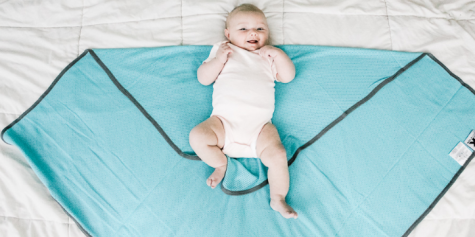How to Swaddle a Baby
April 18, 2019
A baby is used to being packed tightly in a warm, cozy environment. Imitating the environment stops tears and makes a baby feel secure. Swaddling reminds a baby of the comforting confinement of the womb (it’s a big adjustment, it’s like moving out of a tiny one bedroom apartment into a mansion). Not all babies like being swaddled; for some it’s just too hot and confining while others find it delightfully reassuring. You shouldn’t be swaddling your baby night and day, you should always give them a chance to move around to help promote growth and strength in their limbs. Babies have a startle reflex (also known as a Moro reflex) which can wake them from an otherwise peaceful sleep. Keeping a baby’s arms in a swaddle can stop this reflex from waking them up. Keep reading to find out how to properly swaddle a newborn.

Step 1: Lay a blanket down on a safe, flat place. Thin or lightweight material is ideal for a swaddle blanket. Sizes can vary, as they’re often meant to fit babies of different sizes. Place the blanket in a diamond shape/position with the top corner folded down 4-6 inches, for baby’s head. Lay the baby down on their back in the center of the blanket with their neck on the folded corner.

Step 2: Take the left corner of the diamond shape, and bring it over the baby’s chest while holding the baby’s arm to their side, and tuck it securely under the baby’s back and bottom. Leave room for your baby’s legs to move. Make sure the swaddle is not covering the baby’s face, or that the swaddle is not too loose.

Step 3: Bring the bottom corner up towards the right shoulder, and tuck it in firmly into the first cross-section. Make sure the legs (and especially the hips) have room to move around.

Step 4: Wrap the remaining part of the swaddle by taking the right corner and pulling it snugly across the body while pinning down the right arm. Tuck the swaddle around baby’s back, if desired, tuck in the remaining fabric.
Swaddling limits movement, so it’s best only for young infants. When you’re laying down a baby for sleep, you should always put them on their backs, which is even more important if they are swaddled. The risk of Sudden Infant Death Syndrome (SIDS) significantly increases when a swaddled baby is placed on their stomach during sleep. A baby can be safely swaddled during sleep until around 9 months, but it’s important to pay attention to their cues. For example, if they’re always trying to break out of the swaddle or moving around a lot, then it may be safer to ditch the blanket. Also, if they are old enough to roll over, they should not be swaddled for sleeping; unless they are watched closely. According to the International Hip Dysplasia Institute, improper swaddling of your baby can cause hip development problems. It states, “Sudden straightening of the legs to a standing position can loosen the joints and damage the soft cartilage of the socket.” The source notes that for proper hip health, the baby’s legs should be able to move upwards and outwards at the hip and not be tightly wrapped together in an extended position, which may hinder the natural development of the joints. Even if the baby “co-sleeps”, Riefkohl does not recommend swaddling for nighttime sleep.







